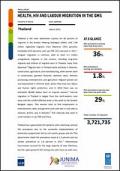Publications - Released in 2014
Thailand is the main destination country for 60 percent of migrants in the Greater Mekong Subregion (GMS), with 1.48 million registered migrants from Myanmar (78.6 percent), Cambodia (10.9 percent), and Lao PDR (10.5 percent) in 2011.
Irregular migration is common, with at least 1.5 million unregistered migrants in the country, including long-term migrants and children of migrants born in Thailand, many from Myanmar. Migrant men in Thailand work primarily in fisheries, construction, agriculture, and manufacturing, while women work in construction, garment factories, domestic work, fisheries processing, entertainment, and agriculture. Migrant women are overrepresented in informal work, where they have less labour and human rights protection; and in 2010 there was an estimated 98,000 babies born to migrant women. Internal migration in Thailand is largely from the north-eastern rural areas and the conflict-affected areas in the south to the Greater Bangkok region. Thai women tend to find employment in entertainment, sales, and garment work and men in such jobs as cleaners, drivers, and in factories. Thai nationals also work in small numbers in Lao PDR and China.
Downloads
Organizations
- Asian Development Bank (ADB)
- Joint United Nations Initiative on Migration, Health and HIV in Asia (JUNIMA)
- United Nations Development Programme (UNDP)






